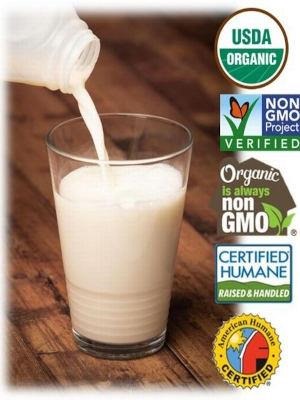By Danielle Ufer and David Ortega
Do consumers care about redundant milk labels?

The consumer eye has increasingly turned toward production traits like improved animal welfare standards or the absence of genetically modified organisms (GMOs). Improving supply-side communication can be critical to meeting changing demands. Labels placed directly on product packaging are a part of key strategies to communicate with consumers.
Some labels popping up in grocery stores, especially in the dairy aisle, redundantly point out things like "Organic is always non-GMO," information which is theoretically already captured in the USDA organic label on its own. Since these labels don't communicate any information that isn't already present in the comprehensive USDA organic label, we wanted to investigate whether these redundant labels were actually valuable to the consumer and, if they were, whether that value persisted even after the consumer was informed and understood the redundancy. In our new article, recently published in Applied Economic Perspectives & Policy, we do just that.
To study consumer reactions to these redundant labels and whether they were valuable, we went to a local Michigan grocery store to find some milk consumers. Using a short survey and an economic experiment conducted right next to the dairy case, we elicited consumers' willingness to pay for a half-gallon of milk with various labeling schemes. These schemes included redundant labels on USDA organic milk highlighting the non-GMO or animal-friendly traits of the milk. Using an experiment, we estimated consumer values both before and after telling them about the labels' redundancy. In both cases, we found that the redundant labels were indeed valuable, with consumers willing to pay a premium even greater than they would offer for organic milk without the redundant label. On average, redundant labels increased the premium consumers were willing to pay for an organic half gallon of milk by $0.28 to $0.32, or about an additional 27% to 33% over the organic label's premium on its own.
Taking things a step further, we used the data from our grocery store study to simulate the market shares of these different labeling schemes to see if these redundant labels could effectively recapture any share lost to products that provided fewer traits than the comprehensive label. Based on our data and the modeling assumptions we make, employing a redundant labeling strategy can help organic industry participants recapture 3 to 7% of the market from products that only have one of the many traits organic provides (specifically, non-GMO or animal-friendly characteristics). Overall, our study found that redundant labels can be an effective marketing strategy, both in communicating effectively with the consumer and capturing lost market share.
We identified two types of consumers with unique behavior relative to food labels which can change the way marketers use labels. The differences became clear as we found that value persists for redundant labels for some, but not all, consumers before and after making them aware of the redundancy. This indicated that some consumers simply do not know what the organic label entails and some do, yet still value the reassurance provided by that redundant label's presence. This can shape labeling strategies in the future by considering what is essential to the consumer when they see a label on a food product. It also indicates that informational or educational campaigns for comprehensive labels can still help some consumers and should not be abandoned. Our results also point to a potential opportunity to rethink how the USDA organic program markets and labels products. The current label may not be sufficient to communicate its value to consumers effectively.
The dairy industry is susceptible to consumer demands. In recent years, several processors, in particular yogurt makers, have aimed to increase non-GMO dairy product availability and sales, despite a well-established organic dairy industry. This can create multiple instances in which a redundant labeling strategy may be essential to reducing consumer confusion and holding on to a contentious market share for organic producers and processors. Finding the optimal communication strategy will be especially important as the dairy industry looks to reverse the long-term trend in decreasing beverage milk consumption, and redundant labels may be a key component.
Source : msu.edu